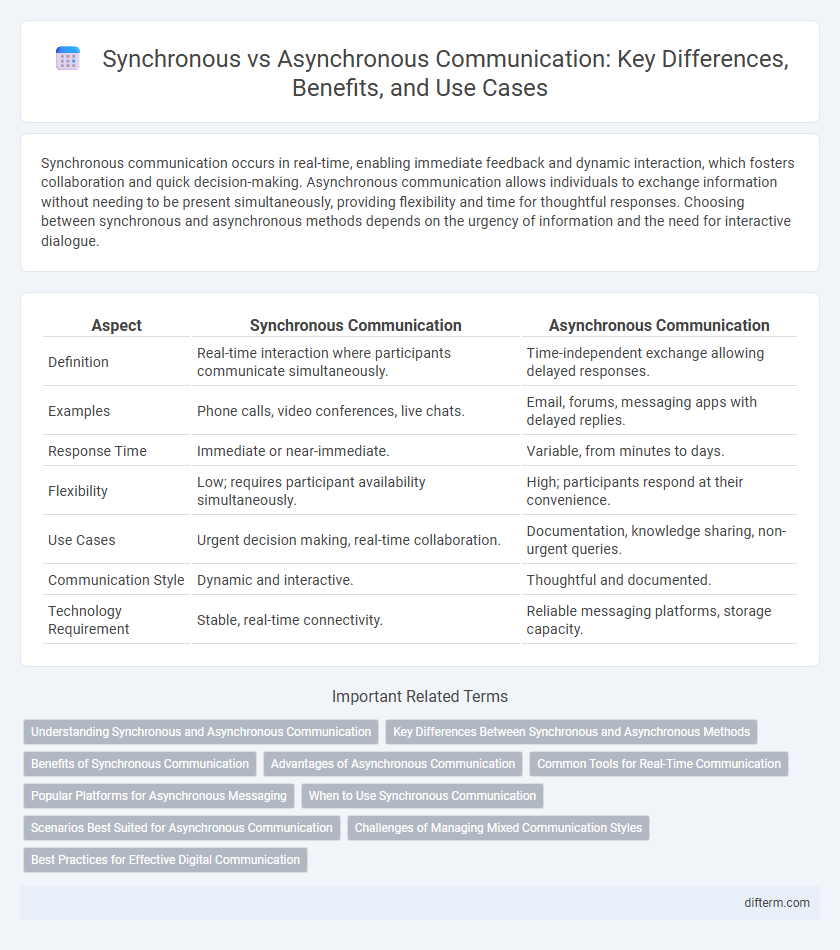Synchronous communication occurs in real-time, enabling immediate feedback and dynamic interaction, which fosters collaboration and quick decision-making. Asynchronous communication allows individuals to exchange information without needing to be present simultaneously, providing flexibility and time for thoughtful responses. Choosing between synchronous and asynchronous methods depends on the urgency of information and the need for interactive dialogue.
Table of Comparison
| Aspect | Synchronous Communication | Asynchronous Communication |
|---|---|---|
| Definition | Real-time interaction where participants communicate simultaneously. | Time-independent exchange allowing delayed responses. |
| Examples | Phone calls, video conferences, live chats. | Email, forums, messaging apps with delayed replies. |
| Response Time | Immediate or near-immediate. | Variable, from minutes to days. |
| Flexibility | Low; requires participant availability simultaneously. | High; participants respond at their convenience. |
| Use Cases | Urgent decision making, real-time collaboration. | Documentation, knowledge sharing, non-urgent queries. |
| Communication Style | Dynamic and interactive. | Thoughtful and documented. |
| Technology Requirement | Stable, real-time connectivity. | Reliable messaging platforms, storage capacity. |
Understanding Synchronous and Asynchronous Communication
Synchronous communication involves real-time interaction, enabling immediate feedback and dynamic conversation flow, typical in video calls, phone chats, or instant messaging. Asynchronous communication allows participants to respond at their convenience, supporting flexibility through emails, forum posts, or recorded messages. Understanding the strengths of synchronous and asynchronous communication is essential for optimizing team collaboration, balancing urgency with thoughtful reflection, and enhancing overall productivity.
Key Differences Between Synchronous and Asynchronous Methods
Synchronous communication requires participants to be present simultaneously, enabling real-time interaction and immediate feedback, often seen in phone calls and video conferences. Asynchronous communication allows participants to engage at different times through channels like emails and messaging platforms, providing flexibility and time for thoughtful responses. Key differences include the speed of interaction, availability necessity, and impact on collaboration dynamics.
Benefits of Synchronous Communication
Synchronous communication enables real-time interaction, fostering immediate feedback and reducing misunderstandings. It enhances collaboration efficiency by allowing participants to quickly clarify points and make decisions collectively. This form of communication is ideal for complex discussions that require active engagement and dynamic exchange of ideas.
Advantages of Asynchronous Communication
Asynchronous communication offers significant advantages by enabling participants to respond at their convenience, enhancing flexibility and reducing pressure for immediate replies. It supports diverse time zones and work schedules, promoting inclusivity and continuous workflow without interruptions. This mode fosters thoughtful, well-crafted messages that improve clarity and reduce miscommunication in team collaborations.
Common Tools for Real-Time Communication
Common tools for real-time communication include video conferencing platforms like Zoom, Microsoft Teams, and Google Meet, which enable instant audio and visual interaction. Instant messaging apps such as Slack and Microsoft Teams facilitate quick text-based exchanges, supporting team collaboration and rapid decision-making. These synchronous tools enhance immediate feedback and active engagement, crucial for dynamic work environments and remote communication.
Popular Platforms for Asynchronous Messaging
Popular platforms for asynchronous messaging include Slack, Microsoft Teams, and Discord, which offer versatile channels for team collaboration and project management. These tools support message threading, file sharing, and integrations with other productivity apps, enhancing workflow efficiency across time zones. Asynchronous communication on these platforms allows users to respond at their convenience, reducing disruptions and promoting focused work.
When to Use Synchronous Communication
Synchronous communication is essential for real-time collaboration when immediate feedback and dynamic interaction are required, such as during team meetings, brainstorming sessions, or client calls. It enhances decision-making speed and helps clarify complex issues quickly, reducing misunderstandings often found in delayed responses. Utilizing tools like video conferencing, instant messaging, or phone calls ensures smooth, uninterrupted dialogue that aligns with urgent and time-sensitive tasks.
Scenarios Best Suited for Asynchronous Communication
Asynchronous communication excels in scenarios where team members operate across different time zones or maintain flexible schedules, allowing for thoughtful responses without real-time pressure. It is ideal for tasks requiring detailed documentation, such as project updates, feedback loops, and knowledge sharing, enhancing clarity and reducing misunderstandings. Remote teams benefit from asynchronous methods through preserved productivity and minimized meeting overload, fostering a balanced workflow.
Challenges of Managing Mixed Communication Styles
Managing mixed communication styles poses challenges such as ensuring timely response coordination between synchronous methods like video calls and asynchronous tools like emails. Misalignment can lead to decreased productivity, misunderstandings, and information silos within teams. Effective strategies must address these issues by balancing real-time interaction needs with flexibility for asynchronous workflows.
Best Practices for Effective Digital Communication
Effective digital communication thrives on choosing synchronous or asynchronous methods based on context, urgency, and participant availability. Synchronous communication, such as video calls and instant messaging, enables real-time interaction and immediate feedback, which is ideal for complex discussions or decision-making. Asynchronous tools like email, project management platforms, and recorded video allow team members to engage thoughtfully across different time zones, promoting thoroughness and reducing interruptions.
synchronous vs asynchronous Infographic

 difterm.com
difterm.com